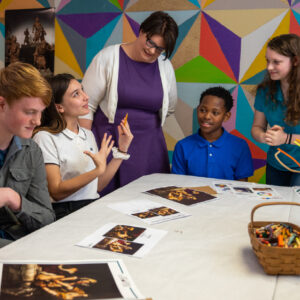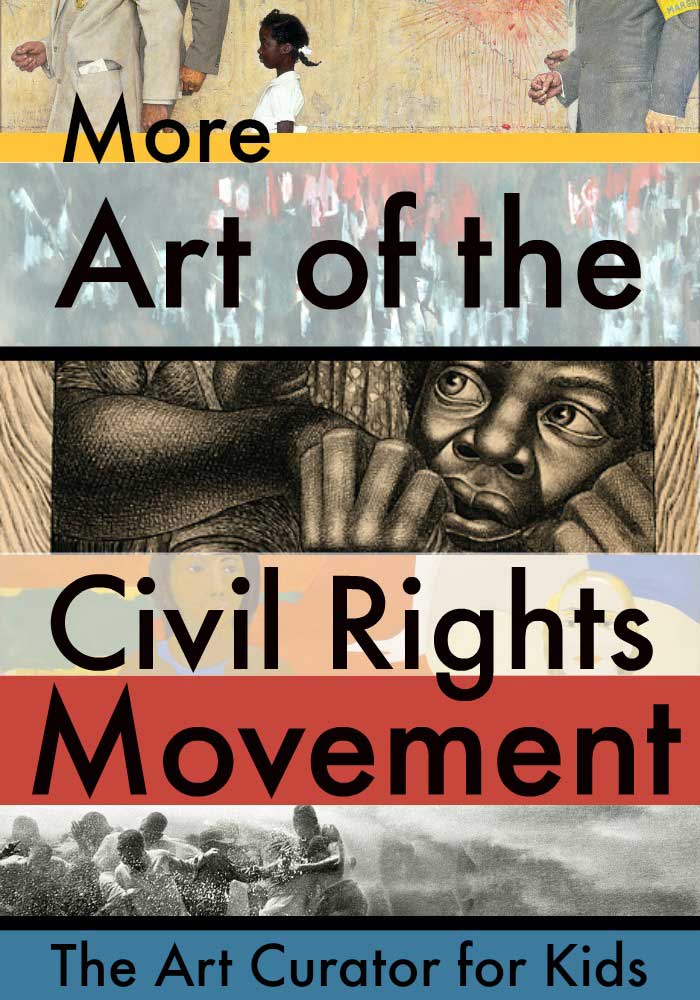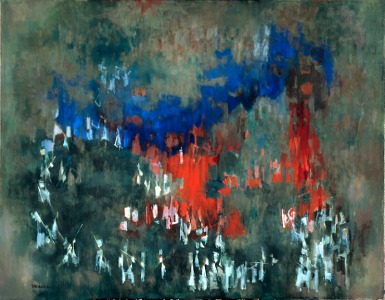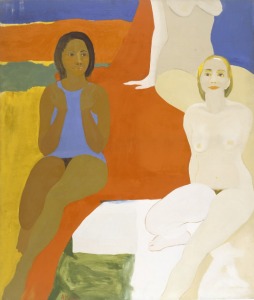One of my favorite posts from last year was Art of the Civil Rights Movement for the Multicultural Kid Blogs MLK Jr. Day Series. I remember finishing the post and looking forward to writing next year’s series post because I had a hard time choosing only 5 artworks! So without further ado, here are 5 more powerful works of art from or about the Civil Rights Movement.
Norman Lewis, Evening Rendezvous, 1962
This artwork instantly made me feel uneasy. I don’t know if it is because I knew it was about the Civil Rights Movement when I first saw it, but I instantly saw the bloodshed, controversy, smoke and flames, and an unequal balance of power. When you look closer beyond the American colors and the expressive brushstrokes, you start to notice the KKK members and their weapons filling the bottom of the picture.
Questions to Ask: What is happening in this painting? How does the artist express meaning through brushstrokes? How do the colors add to the meaning of the artwork? Why did the artist call this painting Rendezvous?
Norman Rockwell, The Problem We All Live With, 1964
I came very close to writing this post only about the Civil Rights Movement art of Norman Rockwell. He painted some incredibly powerful art that strays from his sweet and traditional down-home-American-values artworks. I chose this one to feature for this post because you first see this sweet, innocent girl in crisp, clean school clothes in stark contrast to the smashed tomato and hate language on the wall. It’s just a really powerful work of art.
This girl is Ruby Bridges who was the first black child to attend an all-white elementary school.
I learned while researching this artwork that Norman Rockwell actually ended in contract with the Saturday Evening Post in 1963 because they limited his expression on political topics.
Questions to Ask: What is happening here? Who are the people in the painting? Why is the tomato there? Who threw it? From what perspective are you seeing the work? Why did the artist choose to put you in that position?
Emma Amos, Three Figures, 1966
I actually wasn’t going to include this artwork at first, because it didn’t grab me right away, but once I took a closer look and spent some time comparing the two women, I knew I couldn’t leave it out.
Questions to Ask: Compare and contrast the two main women in the artwork. How do they feel about themselves? What do you see that makes you say that? Note their body positions, clothing (or lack of), and facial expressions.
Maria Varela, Washington County, Mississippi, 1966
I have a tab open on my computer right now with this artwork pulled up, and I keep going back to it. I can’t stop looking at it. It’s a stunningly composed photograph that captures chaos and confusion. I’m having a hard time finding out the history of this one other than this quotation, “The U.S. military evicted more than one hundred plantation workers from the Greenville air force base.”
Questions to Ask: What is happening here? Why did the artist choose to crop the photo in this way? How does the artist use contrast to impact the meaning?
Charles White, Untitled, 1950
The artists in this collection are definitely succeeding in making me feel anxious. That uneasiness is intensified by the cramped, intimate composition, the lack of color, the fearful expressions with exaggerated features, the headless doll, the clutches fists on the larger-than-life hands.
Questions to Ask: How do you feel when looking at this artwork? What choices did the artist make to make you feel this way? What do you think is happening to these two people? Why do they feel the way they do?

Get the Full Lesson!
This Lesson is in The Curated Connections Library!
Find the full lesson from this post along with hundreds of other art teaching resources and trainings in the Curated Connections Library. Click here for more information about how to join or enter your email below for a free SPARKworks lesson from the membership!
Civil Rights Movement Art Resources
Free Resources on the Web:
- Oh Freedom! Teaching African American Civil Rights Through American Art at the Smithsonian – More Artworks, Lesson Plans, and Student-created podcasts
- Witness: Art and Civil Rights in the Sixties
- Engaging Students with Primary Sources
Please note, this post includes Amazon affiliate links. As an Amazon Associate I earn from qualifying purchases.
- The Civil Rights Movement: A Photographic History, 1954-68
- Special Moments in African-American History, 1955-1996: The Photographs of Moneta Sleet, Jr., Ebony Magazine’s Pulitzer Prize Winner
- Child of the Civil Rights Movement
Now, check out some other posts from the Martin Luther King, Jr. Day for Kids series on Multicultural Kid Blogs and link up your own!










